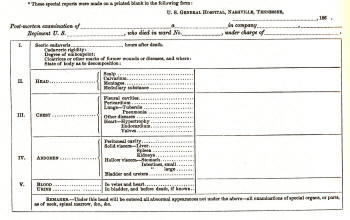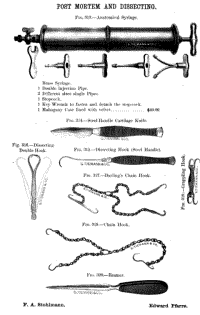By 1862, Surgeons were
solicited by Surgeon General Hammond and staff to forward to the Army Medical
Museum interesting morbid specimens of amputated limbs, images of the same,
projectiles which caused the injuries, etc.. The Medical and Surgical
History (M&SH) is replete with citations regarding the various post-mortem
examinations done by the Union medical staff surgeons. This
information was reported back to the Medical Department and was the beginning of the
Armed Forces Institute Of Pathology.
Union Army Medical
Department
The Union Army's Medical
Department put out special order No. 2 by Dr. Hammond directing surgeons to
collect post-mortem specimens:
CIRCULAR NO.2
Surgeon General's Office Washington DC May 21 1862
Important cases of
every kind should be reported in fall Where post mortem examinations
have been made accounts of the pathological results should be carefully
prepared As it is proposed to establish in Washington an Army Medical
Museum medical officers are directed diligently to collect and to
forward to the office of the Surgeon General all specimens of morbid
anatomy surgical of medical which may be regarded as valuable together
with projectiles and foreign bodies removed and such other matters as
may prove of interest in the study of military medicine or surgery These
objects should be accompanied by short explanatory notes Each specimen
in the collection will have appended the name of the medical officer by
whom it was prepared WILLIAM A HAMMOND, Surgeon-Genera US Army (From The
Army Surgeon's Manual by Wm. Grace)
Form for post-mortem examination as provided by the U.
S. Army during the Civil War

Confederate Army Medical
Bureau
The Confederate Army
Medical Bureau was also requesting post-mortem evaluations during the War.
This citation is from the M&SH:
CONFEDERATE STATES OF
AMERICA, SURGEON-GENERAL'S OFFICE,
Richmond, Va., August 6, 1864.
Surg. ISAIAH H. WHITE, In Charge of Hospital for Federal Prisoners,
Andersonville, Ga.:
SIR: The field for
pathological investigations afforded by the large collection of Federal
prisoners in Georgia is of great extent and importance, and it is
believed that results of value to the profession may be obtained by a
careful investigation of the effects of disease upon this large body of
men subjected to a decided change of climate and to the circumstances
peculiar to prison life. The surgeon in charge of the hospital for
Federal prisoners, together with his assistants, will afford every
facility to Surg. Joseph Jones in the prosecution of the labors ordered
by the Surgeon-General. Efficient assistance must be rendered Surgeon
Jones by the medical officers, not only in his examinations into the
causes and symptoms of the various diseases, but especially in the
arduous labors of post-mortem examinations.
The medical officers
will assist in the performance of such post-mortems as Surgeon Jones may
indicate, in order that this great field for pathological investigation
may be explored for the benefit of the medical department of the
Confederate Army.
S. P. MOORE,
Surgeon-General
CSA






